Smash Burgers Are Better Than Regular Burgers: Here's Why
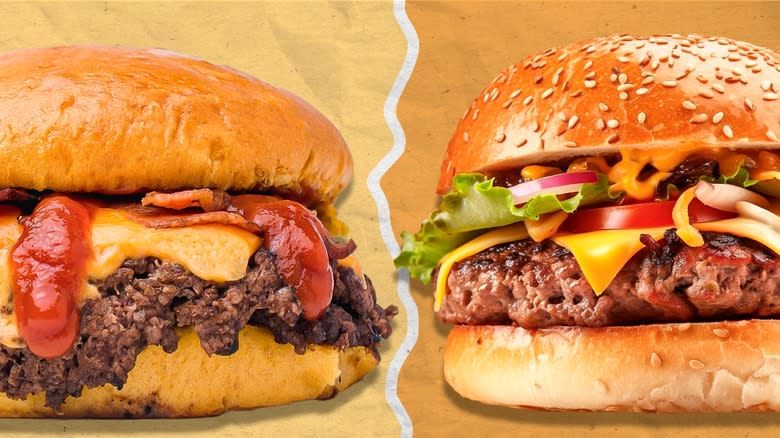
Smash burgers have risen to the forefront of the burger scene in recent years. For the uninitiated, a smash burger is a basic cheeseburger with a patty that has been literally smashed and flattened on the grill or flat top as it's cooked. These juicy, crusty, and super thin patties are usually served simple -- layered two or three patties-high and stacked with cheese and minimal accouterments. Smash burgers have amassed an exponentially growing following as of late, with purveyors and innumerable variants of the sandwich popping up all over the world. But are smash burgers really deserving of all that hype, and what about these burgers has contributed to their surging popularity?
We're here to answer all your burning, caramelizing questions to the best of our burger-loving ability. While we can't decide for everyone, we believe the age-old question, "To smash or not to smash?" leans stronger in one direction than another, and we're here to make the case for why smash burgers are far superior.
Read more: Tips You Need When Cooking With Ground Beef
What Is A Smash Burger?
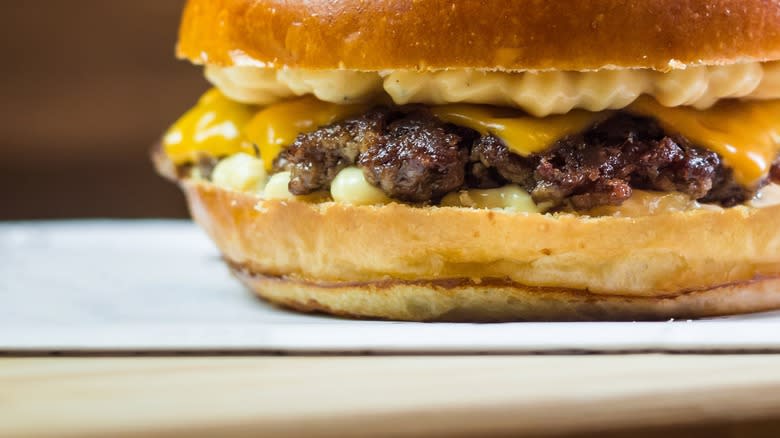
The concept of the smash burger is relatively simple. To make one, a ball of ground beef is placed on a hot griddle and immediately smashed flat with a spatula or weight to create a thin patty. This technique results in a burger with a crispy, caramelized exterior and a juicy, flavorful interior. The thin size allows for more surface area to come into contact with the hot cooking surface, which promotes a crispy crust. Smashed patties also don't curl upward and away from the heat source, giving them a more uniform texture than an unsmashed burger.
Because of their thinness, smash burgers take only a few minutes to cook on each side. The quick and intense sear minimizes moisture loss in the meat and seals the juices in the middle of the patty. In comparison, thicker burgers have to be cooked longer to meet proper serving temperature. Though this is certainly not the case with every patty, a longer cooking time can cause critical moisture loss if the patty is cooked past medium, resulting in a dry burger.
As with any good foodstuff, there are countless variants to regular burgers and smash burgers across the board. Toppings are added and subtracted depending on where you go. Typically, though, a good burger and smash burger see eye-to-eye on lettuce, tomato, onion, and cheese.
History Of The Smash Burger
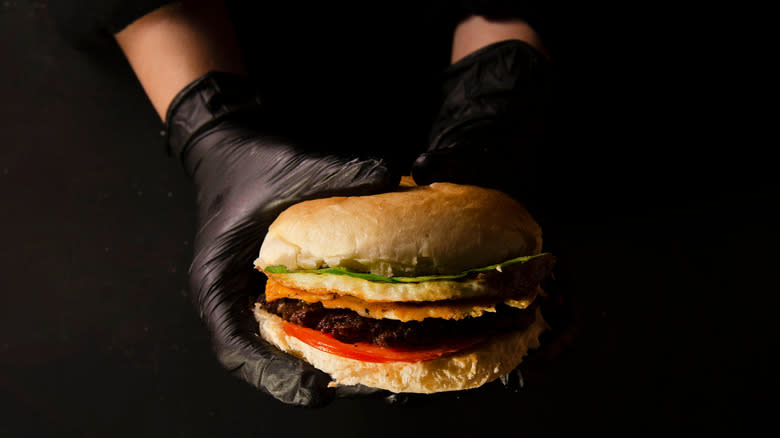
We have to ask what came first — the burger or the smash burger? It's not a chicken or egg mystery here — the burger was first. But, the humble origins of the first smash burger as a viral food are rooted in the Appalachian region of Ashland, Kentucky, where an ordinary burger-flipping cook decided to smash one of his unfinished patties with a large, No. 10 tin can. The restaurant where he worked was known as Dairy Cheer, an off-shoot of the Dairy Queen location it used to be. Owner Bill Culvertson saw an unfilled niche in this strange burger-smashing technique and created the first smash burger, cementing a moment of food history. Culvertson later franchised Dairy Cheer and opened several other locations in the region, a few of which are still open today and continue to tout its history as the "Home of the Smashburger."
While Culvertson gets credit as the first to market and sell a smash burger, historical accounts suggest that the smashing thin of burger patties was around well before Dairy Cheer was pumping out food. During the Great Depression, for instance, Oklahoma's onion burger was created as a way to ration expensive burger meat by making thinner patties and mixing in cheap onions to create a cost-effective and crispy burger.
Selling The Smash Burger
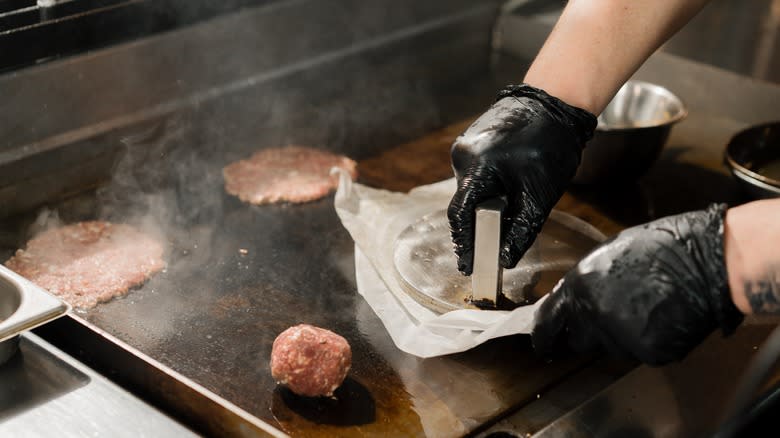
It's no secret smash burgers have made a name for themselves in the modern culinary lexicon. Though they're nothing new, the food trend has seen an upswing in popularity in the last few years. It appears that the "fancy" burger — you know, the one with the big, thick patty piled high with artisan lettuce, aioli, and a bunch of other frills — has fallen out of favor with the times. At the same time, the fancy burger's thinner and much more modest cousin, the smash burger, has been enjoying a prolific moment in the sun, with purveyors of the crusty sandwich competing across major food hubs like New York City. Even famous rappers, like Texas' own Bun B, have staked their claim in the burger hype.
Whole enterprises have also opened around this burger style. Smashburger, which started out as a small spot in Denver, has expanded significantly over the last decade. As soon as it opened in 2007, the franchise dedicated its entire existence to promoting the crispy, thin-pattied burger movement. Smashburger uses its own custom-made presses to achieve the signature patties, which have caught cities, suburbs, and seemingly everywhere in between by storm. The chain boasts over 240 locations across 34 states and seven countries.
Why Smash Burgers Are Better
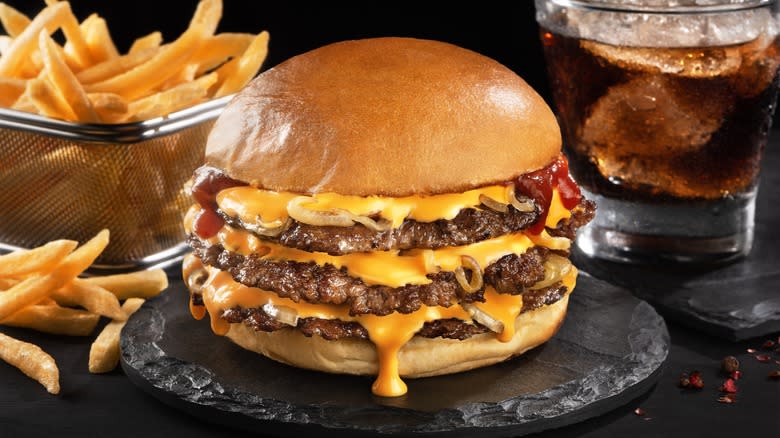
Thin-pattied smash burgers cooked over a flat-top griddle or pan — particularly those that are smashed into a high-heat surface — are simply better than grilled burgers. There are several reasons for this, and it all comes down to the science of making a burger.
The cooking process is critical in setting the smash burger apart. When a hamburger patty is pressed and held against a superheated surface, the Maillard reaction takes maximum effect. This effect describes the process of browning food when cooking, attributed to heat changing the structure of proteins on the surface of food. This browning is what brings out the flavor of umami in certain foods. The smashed patty is closer to the heat source, which compounds the effect of the Maillard reaction. In contrast, a regular-sized burger has limited contact with the heat source, so it doesn't get the same effect. As a result, the ground beef in a thick patty is often less flavorful than a crispy smash burger.
Grill Or Griddle: The Semantics Matter
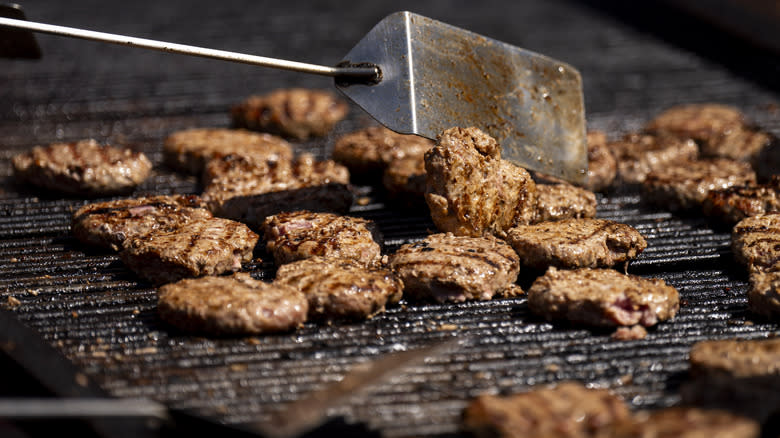
The cooking surface you're making your burger on also matters. Grills and griddles cannot be used interchangeably when cooking hamburgers, as each will produce an entirely different result from the other. If you've ever cooked burgers on grill grates, you might notice that they often curl up away from the heat and create an inverted cup shape. This causes uneven cooking, and unfortunately, pressing the meat with a weight, as one would when making a smash burger, would squeeze the juices out and dehydrate the patty. Or, you risk squishing the meat through the grates and causing the patty to disappear.
In most cases, you will achieve a better-tasting, more consistently-cooked smash burger if you cook it on a flat-top griddle or in a heavy-bottomed pan, like a cast iron skillet. The griddle or skillet conducts heat well and gives you reliable control over the temperature. It also collects all the juices and fats that escape during the cooking process and redistributes them back into the meat. Moreover, the flat surface lends itself well to achieving a stellar Maillard reaction.
Smash Burgers Use Simple Yet Intentional Ingredients
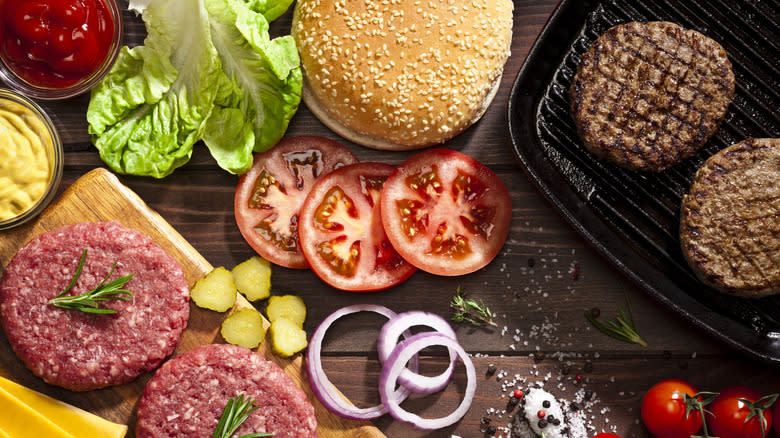
Whereas the big chef burger fad relied on the maximization of over-the-top ingredients — like fried eggs, truffles, and avocado — a smash burger keeps things straightforward. There might not even be a need for these toppings, as noted by a study published by TNT Burgers, which shares that only 35% of surveyed consumers had a strong willingness to pay for these more out-of-the-box toppings.
Part of what makes a smash burger so delicious is its strong, no-frills approach to the sandwich. Smash burgers age back to the days of frugality when excess wasn't feasible, so folks had to make do with what little ingredients they had and take extra care to bring intentionality and perfection to each element of the sandwich. Today, some of the most beloved burgers are the most simple, including In-N-Out Burger's smashed Double-Double, which includes double patties, double cheese, and the standard trio of lettuce, onion, and tomato with a bit of sauce to round out the profile. The idea here is that there is an intention behind each topping and component. When care is taken at each layer, there is no need to hide behind excess.
Smash Burgers Need To Be Prepared Methodically

When talking about intention, it's important to note that the size and thickness of each precariously placed layer of a good smash burger is vitally important. First, because smash burger patties are so thin, they are incredibly stackable. Smash and griddle two or three patties per burger, lay a slice or two of cheese across the top of each one toward the end of cooking to melt it, and pile one atop the other to make a crusty stack. The multiple layers of crispiness from the Maillard reaction, the gooey saltiness of the cheese, and the tender, fatty richness from the interior of the patties create textural harmony.
The patties shouldn't be the only thin thing on your burger. Because the patties are so flat, any ingredients made too thick or hearty can easily overpower the delicate intricacy of the crispy and fatty meat. Likewise, too many extras will distract from the meat's simple but powerful flavor. Stick with the basics: lettuce, tomato, and onion. If you're feeling fancy, you can throw a bit of bacon or caramelized onions on there, but don't go too crazy. Keep your ingredients proportional and evenly distributed -- which means slicing your lettuce finely and your tomatoes and onions thin. Spread them out so they cover the surface of the burger, but don't make too much of a pile. Remember, every layer counts, and you don't want to overpower one with another.
Read the original article on Tasting Table.